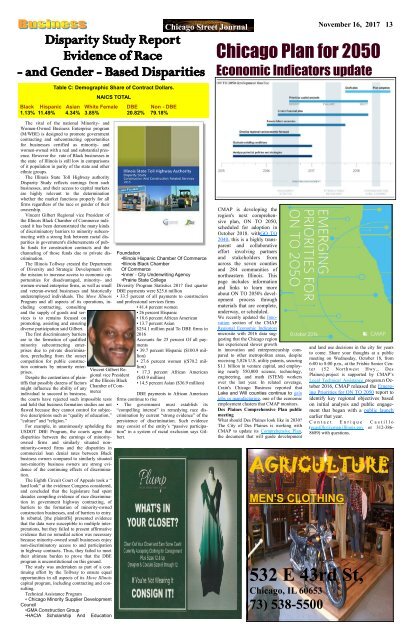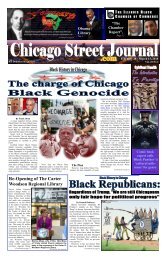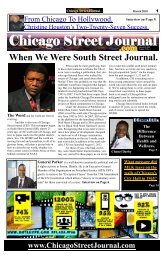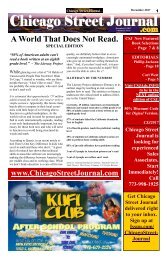Put It In Writing - Chicago Street Journal for November 16, 2017
Chicago Street Journal (CSJ) is city-wide publication and we invite you to submit your articles and stories to us at ChicagoStJournal@gmail.com To place an advertisement call us 773-998-1925.
Chicago Street Journal (CSJ) is city-wide publication and we invite you to submit your articles and stories to us at ChicagoStJournal@gmail.com To place an advertisement call us 773-998-1925.
You also want an ePaper? Increase the reach of your titles
YUMPU automatically turns print PDFs into web optimized ePapers that Google loves.
Table C: Demographic Share of Contract Dollars.<br />
NAICS TOTAL<br />
Black Hispanic Asian White Female DBE Non - DBE<br />
1.13% 11.49% 4.34% 3.85% 20.82% 79.18%<br />
<strong>Chicago</strong> <strong>Street</strong> <strong>Journal</strong> <strong>November</strong> <strong>16</strong>, <strong>2017</strong> 13<br />
<strong>Chicago</strong> Plan <strong>for</strong> 2050<br />
Economic <strong>In</strong>dicators update<br />
The vital of the national Minority- and<br />
Women-Owned Business Enterprise program<br />
(M/WBE) is designed to promote government<br />
contracting and subcontracting opportunities<br />
<strong>for</strong> businesses certified as minority- and<br />
women-owned with a real and substantial presence.<br />
However the rate of Black businesses in<br />
the state of Illinois is still low in comparisons<br />
of it population in parity of the state and other<br />
ethnic groups.<br />
The Illinois State Toll Highway authority<br />
Disparity Study reflects earnings from such<br />
businesses, and their access to capital markets<br />
are highly relevant to the determination<br />
whether the market functions properly <strong>for</strong> all<br />
firms regardless of the race or gender of their<br />
ownership.<br />
Vincent Gilbert Regional vice President of<br />
the Illinois Black Chamber of Commerce indicated<br />
it has been demonstrated the many kinds<br />
of discriminatory barriers to minority subcontracting<br />
with a strong link between racial disparities<br />
in government's disbursements of public<br />
funds <strong>for</strong> construction contracts and the<br />
channeling of those funds due to private discrimination.<br />
The Illinois Tollway created the Department<br />
of Diversity and Strategic Development with<br />
the mission to increase access to economic opportunities<br />
<strong>for</strong> disadvantaged, minority- and<br />
women-owned enterprise firms, as well as small<br />
and veteran-owned businesses and historically<br />
underemployed individuals. The Move Illinois<br />
Program and all aspects of its operations, including<br />
contracting, consulting<br />
and the supply of goods and services<br />
is to remains focused on<br />
promoting, assisting and ensuring<br />
diverse participation said Gilbert.<br />
The first discriminatory barriers<br />
are to the <strong>for</strong>mation of qualified<br />
minority subcontracting enterprises<br />
due to private discrimination,<br />
precluding from the outset<br />
competition <strong>for</strong> public construction<br />
contracts by minority enterprises.<br />
Despite the contentions of plaintiffs<br />
that possibly dozens of factors<br />
might influence the ability of any<br />
individual to succeed in business,<br />
Vincent Gilbert Regional<br />
vice President<br />
of the Illinois Black<br />
Chamber of Commerce<br />
the courts have rejected such impossible tests<br />
and held that business <strong>for</strong>mation studies are not<br />
flawed because they cannot control <strong>for</strong> subjective<br />
descriptions such as “quality of education,”<br />
“culture” and “religion.”<br />
For example, in unanimously upholding the<br />
USDOT DBE Program, the courts agree that<br />
disparities between the earnings of minorityowned<br />
firms and similarly situated nonminority-owned<br />
firms and the disparities in<br />
commercial loan denial rates between Black<br />
business owners compared to similarly situated<br />
non-minority business owners are strong evidence<br />
of the continuing effects of discrimination.<br />
The Eighth Circuit Court of Appeals took a “<br />
hard look” at the evidence Congress considered,<br />
and concluded that the legislature had spent<br />
decades compiling evidence of race discrimination<br />
in government highway contracting, of<br />
barriers to the <strong>for</strong>mation of minority-owned<br />
construction businesses, and of barriers to entry.<br />
<strong>In</strong> rebuttal, [the plaintiffs] presented evidence<br />
that the data were susceptible to multiple interpretations,<br />
but they failed to present affirmative<br />
evidence that no remedial action was necessary<br />
because minority-owned small businesses enjoy<br />
non-discriminatory access to and participation<br />
in highway contracts. Thus, they failed to meet<br />
their ultimate burden to prove that the DBE<br />
program is unconstitutional on this ground.<br />
The study was undertaken as part of a continuing<br />
ef<strong>for</strong>t by the Tollway to ensure equal<br />
opportunities in all aspects of its Move Illinois<br />
capital program, including contracting and consulting.<br />
Technical Assistance Program<br />
• <strong>Chicago</strong> Minority Supplier Development<br />
Council<br />
•GMA Construction Group<br />
•HACIA Scholarship And Education<br />
Foundation<br />
•Illinois Hispanic Chamber Of Commerce<br />
•Illinois Black Chamber<br />
Of Commerce<br />
•<strong>In</strong>ner ‐ City Underwriting Agency<br />
•Prairie State College<br />
Diversity Program Statistics <strong>2017</strong> first quarter<br />
DBE payments were $25.6 million<br />
• 33.5 percent of all payments to construction<br />
and professional services firms<br />
• 41.4 percent women<br />
• 26 percent Hispanic<br />
• 18.6 percent African American<br />
• 13.7 percent Asian<br />
$254.1 million paid To DBE firms in<br />
20<strong>16</strong><br />
Accounts <strong>for</strong> 25 percent Of all payments<br />
• 39.7 percent Hispanic ($100.9 million)<br />
• 27.6 percent women (($70.2 million)<br />
• 17.3 percent African American<br />
($43.9 million)<br />
• 14.5 percent Asian ($36.9 million)<br />
DBE payments to African American<br />
firms continue to rise<br />
• The government must establish its<br />
“compelling interest” in remedying race discrimination<br />
by current “strong evidence” of the<br />
persistence of discrimination. Such evidence<br />
may consist of the entity’s “passive participation”<br />
in a system of racial exclusion says Gilbert.<br />
CMAP is developing the<br />
region's next comprehensive<br />
plan, ON TO 2050,<br />
scheduled <strong>for</strong> adoption in<br />
October 2018. withGO TO<br />
2040, this is a highly transparent<br />
and collaborative<br />
ef<strong>for</strong>t involving partners<br />
and stakeholders from<br />
across the seven counties<br />
and 284 communities of<br />
northeastern Illinois. This<br />
page includes in<strong>for</strong>mation<br />
and links to learn more<br />
about ON TO 2050's development<br />
process through<br />
materials that are complete,<br />
underway, or scheduled.<br />
We recently updated the <strong>In</strong>novation<br />
section of the CMAP<br />
Regional Economic <strong>In</strong>dicators<br />
microsite with 20<strong>16</strong> data suggesting<br />
that the <strong>Chicago</strong> region<br />
has experienced slower growth<br />
in innovation and entrepreneurship compared<br />
to other metropolitan areas, despite<br />
receiving 3,826 U.S. utility patents, securing<br />
$1.1 billion in venture capital, and employing<br />
nearly 550,000 science, technology,<br />
engineering, and math (STEM) workers<br />
over the last year. <strong>In</strong> related coverage,<br />
Crain's <strong>Chicago</strong> Business reported that<br />
Lake and Will counties continue to gain<br />
jobs in manufacturing, one of the economic<br />
employment clusters that CMAP monitors.<br />
Des Plaines Comprehensive Plan public<br />
meeting<br />
What should Des Plaines look like in 2030?<br />
The City of Des Plaines is working with<br />
CMAP to update its Comprehensive Plan,<br />
the document that will guide development<br />
and land use decisions in the city <strong>for</strong> years<br />
to come. Share your thoughts at a public<br />
meeting on Wednesday, October 18, from<br />
6:00 to 8:00 p.m., at the Frisbie Senior Center<br />
(52 Northwest Hwy., Des<br />
Plaines).project is supported by CMAP’s<br />
Local Technical Assistance program.n October<br />
20<strong>16</strong>, CMAP released the Emerging<br />
Priorities <strong>for</strong> ON TO 2050 report to<br />
identify key regional objectives based<br />
on initial analysis and public engagement<br />
that began with a public launch<br />
earlier that year.<br />
C o n t a c t E n r i q u e C a s t i l l o<br />
(ecastillo@cmap.illinois.gov or 312-386-<br />
8689) with questions.<br />
AGRICULTURE<br />
MEN'S CLOTHING<br />
532 E 43rd St,<br />
<strong>Chicago</strong>, IL 60653<br />
73) 538-5500

















